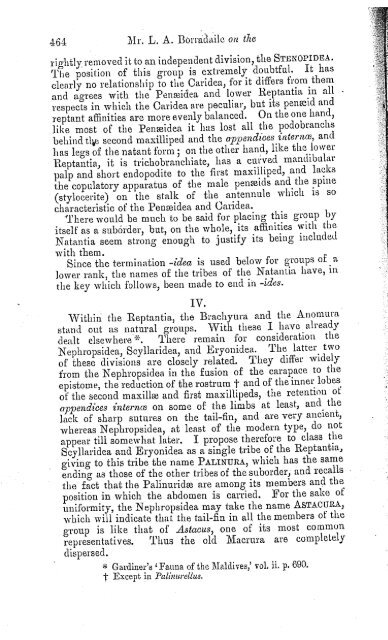On the Classification of the Decapod Crustaceans. By L. A. ...
On the Classification of the Decapod Crustaceans. By L. A. ...
On the Classification of the Decapod Crustaceans. By L. A. ...
Create successful ePaper yourself
Turn your PDF publications into a flip-book with our unique Google optimized e-Paper software.
464 Mr. L. A. Bbrradaile on <strong>the</strong><br />
rightly, removed it to an independent division, <strong>the</strong> STENOPIDEA.<br />
The position <strong>of</strong> this group is extremely doubtful. It has<br />
clearly no relationship to <strong>the</strong> Caridea, for it differs from <strong>the</strong>m<br />
and agrees with <strong>the</strong> Penajidea and lower Reptantia in all -<br />
respects in which <strong>the</strong> Caridea are peculiar, but its penaeid and<br />
reptant affinities are more evenly balanced. <strong>On</strong> <strong>the</strong> one hand,<br />
like most <strong>of</strong> <strong>the</strong> Penseidea it has lost all <strong>the</strong> podobranchs<br />
behind tl^j second maxilliped and <strong>the</strong> appendices internee, and<br />
has legs <strong>of</strong> <strong>the</strong> natant form ; on <strong>the</strong> o<strong>the</strong>r hand, like <strong>the</strong> lower<br />
Reptantia, it is trichobranchiate, has a curved mandibular<br />
palp and short endopodite to <strong>the</strong> first maxilliped, and lacks<br />
<strong>the</strong> copulatory apparatus <strong>of</strong> <strong>the</strong> male penEeids and <strong>the</strong> spine<br />
(stylocerite) on <strong>the</strong> stalk <strong>of</strong> <strong>the</strong> antennule which is so<br />
characteristic <strong>of</strong> <strong>the</strong> Penseidea and Caridea.<br />
There would be much to be said for placing this group by<br />
itself as a suborder, but, on <strong>the</strong> whole, its affinities with <strong>the</strong><br />
Natantia seem strong enough to justify its being" included<br />
with <strong>the</strong>m.<br />
Since <strong>the</strong> termination -idea is used below for groups <strong>of</strong> a<br />
lower rank, <strong>the</strong> names <strong>of</strong> <strong>the</strong> tribes <strong>of</strong> <strong>the</strong> Natantia have, in<br />
<strong>the</strong> key which follows, been made to end in -ides.<br />
IV.<br />
Within <strong>the</strong> Reptantia, <strong>the</strong> Bracliyura and <strong>the</strong> Anomura<br />
stand out as natural groups. With <strong>the</strong>se I have already<br />
dealt elsewhere*. There remain for consideration <strong>the</strong><br />
Nephropsidea, Scyllaridea, and Eryonidea. The latter two<br />
<strong>of</strong> <strong>the</strong>se divisions are closely related. They differ widely<br />
from <strong>the</strong> Nephropsidea in <strong>the</strong> fusion <strong>of</strong> <strong>the</strong> carapace to <strong>the</strong><br />
epistome, <strong>the</strong> reduction <strong>of</strong> <strong>the</strong> rostrum f and <strong>of</strong> <strong>the</strong> inner lobes<br />
<strong>of</strong> <strong>the</strong> second maxillse and first maxillipeds, <strong>the</strong> retention <strong>of</strong><br />
appendices internee on some <strong>of</strong> <strong>the</strong> limbs at least, and <strong>the</strong><br />
lack <strong>of</strong> sharp sutures on <strong>the</strong> tail-fin, and are very ancient,<br />
whereas Nephropsidea, at least <strong>of</strong> <strong>the</strong> modern type, do not<br />
appear till somewhat later. I propose <strong>the</strong>refore to class <strong>the</strong><br />
Scyllaridea and Eryonidea as a single tribe <strong>of</strong> <strong>the</strong> Reptantia,<br />
giving to this tribe <strong>the</strong> name PALINURA, which has <strong>the</strong> same<br />
ending as those <strong>of</strong> <strong>the</strong> o<strong>the</strong>r tribes <strong>of</strong> <strong>the</strong> suborder, and recalls<br />
<strong>the</strong> fact that <strong>the</strong> PalinuridEe are among its members and <strong>the</strong><br />
position in which <strong>the</strong> abdomen is carried. For <strong>the</strong> sake <strong>of</strong><br />
uniformity, <strong>the</strong> Nephropsidea may take <strong>the</strong> name AsTACUKA,<br />
which will indicate that <strong>the</strong> tail-fin in all <strong>the</strong> members <strong>of</strong> <strong>the</strong><br />
group is like that <strong>of</strong> Astacus, one <strong>of</strong> its most common<br />
representatives. Thus <strong>the</strong> old Macrura are completely<br />
dispersed.<br />
* Gardiner's ' Fauna <strong>of</strong> <strong>the</strong> Maldives,' vol. ii. p. 690.<br />
t Except in Palinurellus.
















